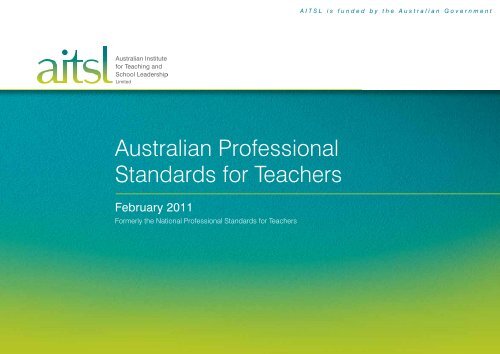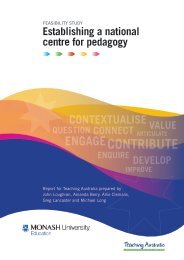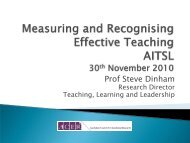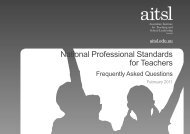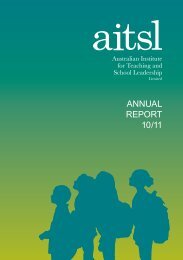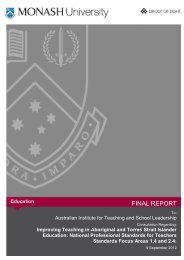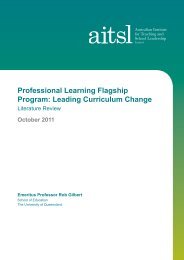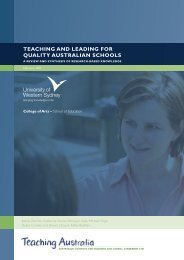pdf, 289kb - AITSL, Australian Professional Standards for Teachers
pdf, 289kb - AITSL, Australian Professional Standards for Teachers
pdf, 289kb - AITSL, Australian Professional Standards for Teachers
You also want an ePaper? Increase the reach of your titles
YUMPU automatically turns print PDFs into web optimized ePapers that Google loves.
<strong>AITSL</strong> is funded by the <strong>Australian</strong> Government<strong>Australian</strong> <strong>Professional</strong><strong>Standards</strong> <strong>for</strong> <strong>Teachers</strong>February 2011Formerly the National <strong>Professional</strong> <strong>Standards</strong> <strong>for</strong> <strong>Teachers</strong>
Work on the <strong>Australian</strong> <strong>Professional</strong> <strong>Standards</strong> <strong>for</strong> <strong>Teachers</strong> (the <strong>Standards</strong>) commenced under the auspicesof the Ministerial Council <strong>for</strong> Education, Early Childhood Development and Youth Affairs (MCEECDYA) in2009. Significant work was undertaken by the National <strong>Standards</strong> Sub-group of the <strong>Australian</strong> Education,Early Childhood Development and Youth Affairs Senior Officials Committee (AEEYSOC) during 2009-10.The <strong>Australian</strong> Institute <strong>for</strong> Teaching and School Leadership (<strong>AITSL</strong>) assumed responsibility <strong>for</strong> validatingand finalising the <strong>Standards</strong> in July 2010.The <strong>Australian</strong> <strong>Professional</strong> <strong>Standards</strong> <strong>for</strong> <strong>Teachers</strong> were endorsed by MCEECDYA in December 2010.<strong>AITSL</strong> appreciates Ministers’ commitment to quality teaching and to the National Partnership on ImprovingTeacher Quality, and looks <strong>for</strong>ward to continuing work with them on these important national re<strong>for</strong>ms.© 2011 Education Services Australia as the legal entity <strong>for</strong> the Ministerial Council <strong>for</strong> Education,Early Childhood Development and Youth Affairs (MCEECDYA). ISBN: 978-0-9871650-3-9Education Services Australia, as the legal entity <strong>for</strong> the Ministerial Council <strong>for</strong> Education, Early ChildhoodDevelopment and Youth Affairs (MCEECDYA) owns the copyright in this publication. This publication orany part of it may be used freely only <strong>for</strong> non-profit education purposes provided the source is clearlyacknowledged. The publication may not be sold or used <strong>for</strong> any other commercial purpose.Other than as permitted above or by the Copyright Act 1968 (Commonwealth), no part of this publication maybe reproduced, stored, published, per<strong>for</strong>med, communicated or adapted, regardless of the <strong>for</strong>m or means(electronic, photocopying or otherwise), without the prior written permission of the copyright owner. Addressinquiries regarding copyright to:MCEECDYA Secretariat, PO Box 202, Carlton South, VIC 3053, Australia.The <strong>Australian</strong> Institute <strong>for</strong> Teaching and School Leadership was <strong>for</strong>med to provide national leadership <strong>for</strong>the Commonwealth, state and territory governments in promoting excellence in the profession of teachingand school leadership with funding provided by the <strong>Australian</strong> Government.ii<strong>Australian</strong> <strong>Professional</strong> <strong>Standards</strong> <strong>for</strong> <strong>Teachers</strong>
PreambleThe crucial role of the teacher<strong>Teachers</strong> share a significant responsibility inpreparing young people to lead successful andproductive lives. The <strong>Australian</strong> <strong>Professional</strong><strong>Standards</strong> <strong>for</strong> <strong>Teachers</strong> (the <strong>Standards</strong>) * reflect andbuild on national and international evidence thata teacher’s effectiveness has a powerful impacton students, 1 with broad consensus that teacherquality is the single most important in-schoolfactor influencing student achievement. 2 Effectiveteachers can be a source of inspiration and, equallyimportantly, provide a dependable and consistentinfluence on young people as they make choicesabout further education, work and life.As stated in the National Partnership on ImprovingTeacher Quality 3 and the Melbourne Declaration onEducational Goals <strong>for</strong> Young <strong>Australian</strong>s, 4 improvingteacher quality is considered an essential re<strong>for</strong>mas part of Australia’s ef<strong>for</strong>ts to improve studentattainment and ensure it has a world class systemof education. ‘The greatest resource in <strong>Australian</strong>schools is our teachers. They account <strong>for</strong> the vastmajority of expenditure in school education andhave the greatest impact on student learning, faroutweighing the impact of any other educationprogram or policy’. 5Internationally 6 and locally, education systems aredeveloping professional standards <strong>for</strong> teachersto attract, develop, recognise and retain qualityteachers. ‘High per<strong>for</strong>ming school systems,though strikingly different in construct and context,[maintain] a strong focus on improving instructionbecause of its direct impact upon studentachievement’. 7<strong>Professional</strong> standards <strong>for</strong>teachersDeveloping professional standards <strong>for</strong> teachersthat can guide professional learning, practice andengagement facilitates the improvement of teacherquality and contributes positively to the publicstanding of the profession. The key elements ofquality teaching are described in the <strong>Standards</strong>.They articulate what teachers are expected to knowand be able to do at four career stages: Graduate,Proficient, Highly Accomplished and Lead.The <strong>Standards</strong> and their descriptors represent ananalysis of effective, contemporary practice byteachers throughout Australia. Their developmentincluded a synthesis of the descriptions ofteachers’ knowledge, practice and professionalengagement used by teacher accreditation andregistration authorities, employers and professionalassociations. Each descriptor has been in<strong>for</strong>medby teachers’ understanding of what is requiredat different stages of their careers. An extensivevalidation process involving almost 6,000 teachersensured that each descriptor was shaped by theprofession.“The greatest resource in <strong>Australian</strong>schools is our teachers. They account <strong>for</strong>the vast majority of expenditure in schooleducation and have the greatest impacton student learning, far outweighing theimpact of any other education programor policy.”The <strong>Standards</strong> support the Melbourne Declaration, 8which describes aspirations <strong>for</strong> all young <strong>Australian</strong>s<strong>for</strong> the next decade. This commits <strong>Australian</strong>Education Ministers to the specific educationalgoals that <strong>Australian</strong> schooling promotes equityand excellence and that all young <strong>Australian</strong>s willbecome successful learners, confident and creativeindividuals, and active and in<strong>for</strong>med citizens. 9 ‘All<strong>Australian</strong> governments, universities, school sectorsand individual schools have a responsibility to worktogether to support high-quality teaching and schoolleadership, including by enhancing pre-service 10teacher education’. 11* Prior to December 2012, the <strong>Australian</strong> <strong>Professional</strong> <strong>Standards</strong> <strong>for</strong> <strong>Teachers</strong> were known as the National <strong>Professional</strong> <strong>Standards</strong> <strong>for</strong> <strong>Teachers</strong>.<strong>Australian</strong> <strong>Professional</strong> <strong>Standards</strong> <strong>for</strong> <strong>Teachers</strong>1
Purpose of the <strong>Standards</strong>The <strong>Australian</strong> <strong>Professional</strong> <strong>Standards</strong> <strong>for</strong> <strong>Teachers</strong>are a public statement of what constitutes teacherquality. They define the work of teachers andmake explicit the elements of high-quality, effectiveteaching in 21st century schools that will improveeducational outcomes <strong>for</strong> students. The <strong>Standards</strong>do this by providing a framework which makesclear the knowledge, practice and professionalengagement required across teachers’ careers.They present a common understanding andlanguage <strong>for</strong> discourse between teachers, teachereducators, teacher organisations, professionalassociations and the public.Teacher standards also in<strong>for</strong>m the development ofprofessional learning goals, provide a frameworkby which teachers can judge the success oftheir learning and assist self-reflection and selfassessment.12 <strong>Teachers</strong> can use the <strong>Standards</strong> torecognise their current and developing capabilities,professional aspirations and achievements.<strong>Standards</strong> contribute to the professionalisation ofteaching and raise the status of the profession. Theycould also be used as the basis <strong>for</strong> a professionalaccountability model, 13 helping to ensure thatteachers can demonstrate appropriate levels ofprofessional knowledge, professional practice andprofessional engagement.The <strong>Australian</strong> <strong>Professional</strong> <strong>Standards</strong> <strong>for</strong> <strong>Teachers</strong>are organised into four career stages and guidethe preparation, support and development ofteachers. The stages reflect the continuum of ateacher’s developing professional expertise fromundergraduate preparation through to being anexemplary classroom practitioner and a leader in theprofession.The Graduate <strong>Standards</strong> will underpin theaccreditation of initial teacher education programs.Graduates from accredited programs qualify <strong>for</strong>registration 14 in each state and territory.The Proficient <strong>Standards</strong> will be used to underpinprocesses <strong>for</strong> full registration as a teacher and tosupport the requirements of nationally consistentteacher registration.The <strong>Standards</strong> at the career stages of HighlyAccomplished and Lead will in<strong>for</strong>m voluntarycertification. 152 <strong>Australian</strong> <strong>Professional</strong> <strong>Standards</strong> <strong>for</strong> <strong>Teachers</strong>
Organisation of the<strong>Australian</strong> <strong>Professional</strong> <strong>Standards</strong> <strong>for</strong> <strong>Teachers</strong>The <strong>Australian</strong> <strong>Professional</strong> <strong>Standards</strong> <strong>for</strong> <strong>Teachers</strong> comprise seven <strong>Standards</strong> which outline what teachersshould know and be able to do. The <strong>Standards</strong> are interconnected, interdependent and overlapping.The <strong>Standards</strong> are grouped into three domains of teaching; <strong>Professional</strong> Knowledge, <strong>Professional</strong> Practiceand <strong>Professional</strong> Engagement. In practice, teaching draws on aspects of all three domains.Within each Standard focus areas provide further illustration of teaching knowledge, practice andprofessional engagement. These are then separated into Descriptors at four professional career stages:Graduate, Proficient, Highly Accomplished and Lead.Domains of teaching <strong>Standards</strong> Focus areas and descriptors<strong>Professional</strong> Knowledge 1. Know students and how they learn Refer to the Standardat each career stage2. Know the content and how to teach it<strong>Professional</strong> Practice3. Plan <strong>for</strong> and implement effective teaching and learning4. Create and maintain supportive and safe learning environments5. Assess, provide feedback and report on student learning<strong>Professional</strong> Engagement6. Engage in professional learning7. Engage professionally with colleagues, parents/carersand the community<strong>Australian</strong> <strong>Professional</strong> <strong>Standards</strong> <strong>for</strong> <strong>Teachers</strong>3
Organisation of the <strong>Standards</strong>Domains of teaching<strong>Professional</strong> Knowledge<strong>Teachers</strong> draw on a body of professional knowledgeand research to respond to the needs of theirstudents within their educational contexts.<strong>Teachers</strong> know their students well, includingtheir diverse linguistic, cultural and religiousbackgrounds. They know how the experiencesthat students bring to their classroom affect theircontinued learning. They know how to structure theirlessons to meet the physical, social and intellectualdevelopment and characteristics of their students.<strong>Teachers</strong> know the content of their subjectsand curriculum. They know and understand thefundamental concepts, structure and enquiryprocesses relevant to programs they teach.<strong>Teachers</strong> understand what constitutes effective,developmentally appropriate strategies in theirlearning and teaching programs and use thisknowledge to make the content meaningful tostudents.Through their teaching practice, teachers developstudents’ literacy and numeracy within their subjectareas. They are also able to use In<strong>for</strong>mation andCommunication Technology to contextualise andexpand their students’ modes and breadth oflearning.<strong>Professional</strong> Practice<strong>Teachers</strong> are able to make learning engaging andvalued. They are able to create and maintain safe,inclusive and challenging learning environmentsand implement fair and equitable behaviourmanagement plans. They use sophisticatedcommunication techniques.<strong>Teachers</strong> have a repertoire of effective teachingstrategies and use them to implement welldesignedteaching programs and lessons. Theyregularly evaluate all aspects of their teachingpractice to ensure they are meeting the learningneeds of their students. They interpret and usestudent assessment data to diagnose barriers tolearning and to challenge students to improve theirper<strong>for</strong>mance.They operate effectively at all stages of the teachingand learning cycle, including planning <strong>for</strong> learningand assessment, developing learning programs,teaching, assessing, providing feedback on studentlearning and reporting to parents/carers.<strong>Professional</strong> Engagement<strong>Teachers</strong> model effective learning. They identifytheir own learning needs and analyse, evaluate andexpand their professional learning both collegiallyand individually.<strong>Teachers</strong> demonstrate respect and professionalismin all their interactions with students, colleagues,parents/carers and the community. They aresensitive to the needs of parents/carers and cancommunicate effectively with them about theirchildren’s learning.<strong>Teachers</strong> value opportunities to engage withtheir school communities within and beyond theclassroom to enrich the educational context <strong>for</strong>students. They understand the links between school,home and community in the social and intellectualdevelopment of their students.4 <strong>Australian</strong> <strong>Professional</strong> <strong>Standards</strong> <strong>for</strong> <strong>Teachers</strong>
The <strong>Australian</strong> <strong>Professional</strong> <strong>Standards</strong> For <strong>Teachers</strong>The seven <strong>Standards</strong> identify what is expected of teachers within three domains of teaching. <strong>Teachers</strong>’demonstration of the <strong>Standards</strong> will occur within their specific teaching context at their stage of expertise andreflect the learning requirements of the students they teach.Domains of teachingStandard 1:Standard 2:Standard 3:Standard 4:Standard 5:Standard 6:Standard 7:<strong>Standards</strong>1. Know students and how they learn2. Know the content and how to teach it3. Plan <strong>for</strong> and implement effective teaching and learning4. Create and maintain supportive and safe learning environments5. Assess, provide feedback and report on student learning6. Engage in professional learningFocus areas and descriptorsThe focus areas and descriptors identify thecomponents of quality teaching at each careerstage. They constitute agreed characteristics of thecomplex process of teaching. An effective teacheris able to integrate and apply knowledge, practiceand professional engagement as outlined in thedescriptors to create teaching environments inwhich learning is valued.7. Engage professionally with colleagues, parents/carersand the community<strong>Professional</strong> capability at four careerstagesThe four career stages in the <strong>Standards</strong> providebenchmarks to recognise the professional growth ofteachers throughout their careers. The descriptorsacross the four career stages represent increasinglevels of knowledge, practice and professionalengagement <strong>for</strong> teachers. Progression through thestages describes a growing understanding, appliedwith increasing sophistication across a broader andmore complex range of situations.Graduate teachersGraduate teachers have completed a qualificationthat meets the requirements of a nationallyaccredited program of initial teacher education. Theaward of this qualification means that they have metthe Graduate <strong>Standards</strong>.On successful completion of their initial teachereducation, graduate teachers possess the requisiteknowledge and skills to plan <strong>for</strong> and managelearning programs <strong>for</strong> students. They demonstrateknowledge and understanding of the implications<strong>for</strong> learning of students’ physical, cultural, social,linguistic and intellectual characteristics. Theyunderstand principles of inclusion and strategies <strong>for</strong>differentiating teaching to meet the specific learningneeds of students across the full range of abilities.Graduate teachers have an understanding oftheir subject/s, curriculum content and teachingstrategies. They are able to design lessons thatmeet the requirements of curriculum, assessmentand reporting. They demonstrate the capacity tointerpret student assessment data to evaluatestudent learning and modify teaching practice.They know how to select and apply timely andappropriate types of feedback to improve students’learning.Graduate teachers demonstrate knowledge ofpractical strategies to create rapport with studentsand manage student behaviour. They know howto support students’ wellbeing and safety, workingwithin school and system curriculum and legislativerequirements.<strong>Australian</strong> <strong>Professional</strong> <strong>Standards</strong> <strong>for</strong> <strong>Teachers</strong>5
They understand the importance of working ethically,collaborating with colleagues, external professionaland community representatives, and contributing tothe life of the school. <strong>Teachers</strong> understand strategies<strong>for</strong> working effectively, sensitively and confidentiallywith parents/carers and recognise their role in theirchildren’s education.Proficient teachersProficient teachers meet the requirements <strong>for</strong> fullregistration through demonstrating achievement ofthe seven <strong>Standards</strong> at this level.These teachers create effective teaching andlearning experiences <strong>for</strong> their students. They knowthe unique backgrounds of their students and adjusttheir teaching to meet their individual needs anddiverse cultural, social and linguistic characteristics.They develop safe, positive and productive learningenvironments where all students are encouraged toparticipate.They design and implement engaging teachingprograms that meet curriculum, assessment andreporting requirements. They use feedback andassessment to analyse and support their students’knowledge and understanding. Proficient teachersuse a range of sources, including student results, toevaluate their teaching and to adjust their programsto better meet student needs.Proficient teachers are active participants in theirprofession and with advice from colleagues identify,plan and evaluate their own professional learningneeds.Proficient teachers are team members. They workcollaboratively with colleagues; they seek out andare responsive to advice about educational issuesaffecting their teaching practice. They communicateeffectively with their students, colleagues, parents/carers and community members. They behaveprofessionally and ethically in all <strong>for</strong>ums.Highly Accomplished teachersHighly Accomplished teachers are recognised ashighly effective, skilled classroom practitioners androutinely work independently and collaborativelyto improve their own practice and the practice ofcolleagues. They are knowledgeable and activemembers of the school.Highly Accomplished teachers contribute to theircolleagues’ learning. They may also take on rolesthat guide, advise or lead others. They regularlyinitiate and engage in discussions about effectiveteaching to improve the educational outcomes <strong>for</strong>their students.They maximise learning opportunities <strong>for</strong> theirstudents by understanding their backgrounds andindividual characteristics and the impact of thosefactors on their learning. They provide colleagues,including pre-service teachers, with support andstrategies to create positive and productive learningenvironments.Highly Accomplished teachers have in-depthknowledge of subjects and curriculum content withintheir sphere of responsibility. They model soundteaching practices in their teaching areas. Theywork with colleagues to plan, evaluate and modifyteaching programs to improve student learning.They keep abreast of the latest developments intheir specialist content area or across a range ofcontent areas <strong>for</strong> generalist teachers.Highly Accomplished teachers are skilled inanalysing student assessment data and use it toimprove teaching and learning.They are active in establishing an environmentwhich maximises professional learning and practiceopportunities <strong>for</strong> colleagues. They monitor their ownprofessional learning needs and align them to thelearning needs of students.They behave ethically at all times. Their interpersonaland presentation skills are highly developed. Theycommunicate effectively and respectfully withstudents, colleagues, parents/carers and communitymembers.6 <strong>Australian</strong> <strong>Professional</strong> <strong>Standards</strong> <strong>for</strong> <strong>Teachers</strong>
Lead teachersLead teachers are recognised and respected bycolleagues, parents/carers and the communityas exemplary teachers. They have demonstratedconsistent and innovative teaching practice overtime. Inside and outside the school they initiate andlead activities that focus on improving educationalopportunities <strong>for</strong> all students. They establishinclusive learning environments that meet theneeds of students from different linguistic, cultural,religious and socio-economic backgrounds. Theyseek to improve their own practice and to share theirexperience with colleagues.They are skilled in mentoring teachers and preserviceteachers, using activities that developknowledge, practice and professional engagementin others. They promote creative, innovative thinkingamong colleagues.They apply skills and in-depthknowledge and understanding to deliver effectivelessons and learning opportunities and sharethis in<strong>for</strong>mation with colleagues and pre-serviceteachers. They describe the relationship betweenhighly effective teaching and learning in ways thatinspire colleagues to improve their own professionalpractice.They lead processes to improve studentper<strong>for</strong>mance by evaluating and revising programs,analysing student assessment data and takingaccount of feedback from parents/carers. This iscombined with a synthesis of current research oneffective teaching and learning.They represent the school and the teachingprofession in the community. They are professional,ethical and respected individuals inside and outsidethe school.ConclusionThe development of the <strong>Australian</strong> <strong>Professional</strong><strong>Standards</strong> <strong>for</strong> the teaching profession is an integralpart of ensuring quality learning and teaching in<strong>Australian</strong> schools. With their development andimplementation, <strong>Australian</strong> education systems arewell placed to be among the best in the world.These <strong>Standards</strong> build upon the significant workundertaken previously in Australia. They are afundamental component of the re<strong>for</strong>ms agreed toin the National Partnership on Improving TeacherQuality and will help to realise the goals andcommitments set out in the Melbourne Declaration.<strong>Australian</strong> <strong>Professional</strong> <strong>Standards</strong> <strong>for</strong> <strong>Teachers</strong>7
<strong>Professional</strong> KnowledgeStandard 1 – Know students and how they learnFocus area Graduate Proficient Highly Accomplished Lead1.1Physical, social andintellectual developmentand characteristics ofstudentsDemonstrate knowledgeand understanding ofphysical, social andintellectual development andcharacteristics of students andhow these may affect learning.Use teaching strategiesbased on knowledge ofstudents’ physical, social andintellectual development andcharacteristics to improvestudent learning.Select from a flexible and effectiverepertoire of teaching strategies to suitthe physical, social and intellectualdevelopment and characteristics ofstudents.Lead colleagues to select and developteaching strategies to improvestudent learning using knowledge ofthe physical, social and intellectualdevelopment and characteristics ofstudents.1.2Understand howstudents learnDemonstrate knowledge andunderstanding of research intohow students learn and theimplications <strong>for</strong> teaching.Structure teaching programsusing research and collegialadvice about how studentslearn.Expand understanding of how studentslearn using research and workplaceknowledge.Lead processes to evaluate theeffectiveness of teaching programsusing research and workplaceknowledge about how students learn.1.3Students withdiverse linguistic,cultural, religiousand socioeconomicbackgroundsDemonstrate knowledgeof teaching strategiesthat are responsive to thelearning strengths andneeds of students fromdiverse linguistic, cultural,religious and socioeconomicbackgrounds.Design and implementteaching strategies that areresponsive to the learningstrengths and needs ofstudents from diverselinguistic, cultural, religious andsocioeconomic backgrounds.Support colleagues to develop effectiveteaching strategies that addressthe learning strengths and needsof students from diverse linguistic,cultural, religious and socioeconomicbackgrounds.Evaluate and revise school learningand teaching programs, usingexpert and community knowledgeand experience, to meet the needsof students with diverse linguistic,cultural, religious and socioeconomicbackgrounds.8 <strong>Australian</strong> <strong>Professional</strong> <strong>Standards</strong> <strong>for</strong> <strong>Teachers</strong>
Standard 1 – Know students and how they learnFocus area Graduate Proficient Highly Accomplished Lead1.4Strategies <strong>for</strong> teachingAboriginal and TorresStrait Islander studentsDemonstrate broadknowledge and understandingof the impact of culture,cultural identity and linguisticbackground on the educationof students from Aboriginaland Torres Strait Islanderbackgrounds.Design and implementeffective teaching strategiesthat are responsive to thelocal community and culturalsetting, linguistic backgroundand histories of Aboriginal andTorres Strait Islander students.Provide advice and support colleaguesin the implementation of effectiveteaching strategies <strong>for</strong> Aboriginaland Torres Strait Islander studentsusing knowledge of and support fromcommunity representatives.Develop teaching programs thatsupport equitable and ongoingparticipation of Aboriginal and TorresStrait Islander students by engagingin collaborative relationships withcommunity representatives andparents/carers.1.5Differentiate teachingto meet the specificlearning needs ofstudents across the fullrange of abilitiesDemonstrate knowledge andunderstanding of strategies<strong>for</strong> differentiating teachingto meet the specific learningneeds of students across thefull range of abilities.Develop teaching activitiesthat incorporate differentiatedstrategies to meet the specificlearning needs of studentsacross the full range ofabilities.Evaluate learning and teachingprograms, using student assessmentdata, that are differentiated <strong>for</strong> thespecific learning needs of studentsacross the full range of abilities.Lead colleagues to evaluate theeffectiveness of learning and teachingprograms differentiated <strong>for</strong> the specificlearning needs of students across thefull range of abilities.1.6Strategies to support fullparticipation of studentswith disabilityDemonstrate broadknowledge and understandingof legislative requirementsand teaching strategies thatsupport participation andlearning of students withdisability.Design and implementteaching activities that supportthe participation and learningof students with disability andaddress relevant policy andlegislative requirements.Work with colleagues to accessspecialist knowledge, and relevantpolicy and legislation, to developteaching programs that support theparticipation and learning of studentswith disability.Initiate and lead the review of schoolpolicies to support the engagementand full participation of students withdisability and ensure compliance withlegislative and/or system policies.<strong>Australian</strong> <strong>Professional</strong> <strong>Standards</strong> <strong>for</strong> <strong>Teachers</strong>9
Standard 2 – Know the content and how to teach itFocus area Graduate Proficient Highly Accomplished Lead2.1Content and teachingstrategies of theteaching areaDemonstrate knowledgeand understanding of theconcepts, substance andstructure of the content andteaching strategies of theteaching area.Apply knowledge of thecontent and teachingstrategies of the teaching areato develop engaging teachingactivities.Support colleagues using current andcomprehensive knowledge of contentand teaching strategies to developand implement engaging learning andteaching programs.Lead initiatives within the school toevaluate and improve knowledge ofcontent and teaching strategies anddemonstrate exemplary teaching ofsubjects using effective, researchbasedlearning and teaching programs.2.2Content selection andorganisationOrganise content into aneffective learning and teachingsequence.Organise content into coherent,well-sequenced learning andteaching programs.Exhibit innovative practice in theselection and organisation of contentand delivery of learning and teachingprograms.Lead initiatives that utilisecomprehensive content knowledge toimprove the selection and sequencingof content into coherently organisedlearning and teaching programs.2.3Curriculum, assessmentand reportingUse curriculum, assessmentand reporting knowledge todesign learning sequencesand lesson plans.Design and implement learningand teaching programs usingknowledge of curriculum,assessment and reportingrequirements.Support colleagues to plan andimplement learning and teachingprograms using contemporaryknowledge and understanding ofcurriculum, assessment and reportingrequirements.Lead colleagues to developlearning and teaching programsusing comprehensive knowledge ofcurriculum, assessment and reportingrequirements.10 <strong>Australian</strong> <strong>Professional</strong> <strong>Standards</strong> <strong>for</strong> <strong>Teachers</strong>
Standard 2 – Know the content and how to teach itFocus area Graduate Proficient Highly Accomplished Lead2.4Understand and respectAboriginal and TorresStrait Islander people topromote reconciliationbetween Indigenousand non-Indigenous<strong>Australian</strong>sDemonstrate broadknowledge of, understandingof and respect <strong>for</strong> Aboriginaland Torres Strait Islanderhistories, cultures andlanguages.Provide opportunities<strong>for</strong> students to developunderstanding of and respect<strong>for</strong> Aboriginal and Torres StraitIslander histories, cultures andlanguages.Support colleagues with providingopportunities <strong>for</strong> students to developunderstanding of and respect <strong>for</strong>Aboriginal and Torres Strait Islanderhistories, cultures and languages.Lead initiatives to assist colleagueswith opportunities <strong>for</strong> students todevelop understanding of and respect<strong>for</strong> Aboriginal and Torres Strait Islanderhistories, cultures and languages.2.5Literacy and numeracystrategiesKnow and understand literacyand numeracy teachingstrategies and their applicationin teaching areas.Apply knowledge andunderstanding of effectiveteaching strategies tosupport students’ literacy andnumeracy achievement.Support colleagues to implementeffective teaching strategies to improvestudents’ literacy and numeracyachievement.Monitor and evaluate theimplementation of teaching strategieswithin the school to improve students’achievement in literacy and numeracyusing research-based knowledge andstudent data.2.6In<strong>for</strong>mation andCommunicationTechnology (ICT)Implement teachingstrategies <strong>for</strong> using ICT toexpand curriculum learningopportunities <strong>for</strong> students.Use effective teachingstrategies to integrate ICTinto learning and teachingprograms to make selectedcontent relevant andmeaningful.Model high-level teaching knowledgeand skills and work with colleaguesto use current ICT to improve theirteaching practice and make contentrelevant and meaningful.Lead and support colleagues withinthe school to select and use ICT witheffective teaching strategies to expandlearning opportunities and contentknowledge <strong>for</strong> all students.<strong>Australian</strong> <strong>Professional</strong> <strong>Standards</strong> <strong>for</strong> <strong>Teachers</strong>11
<strong>Professional</strong> PracticeStandard 3 – Plan <strong>for</strong> and implement effective teaching and learningFocus area Graduate Proficient Highly Accomplished Lead3.1 Establish challenginglearning goalsSet learning goals that provideachievable challenges <strong>for</strong>students of varying abilitiesand characteristics.Set explicit, challenging andachievable learning goals <strong>for</strong>all students.Develop a culture of high expectations<strong>for</strong> all students by modelling andsetting challenging learning goals.Demonstrate exemplary practice andhigh expectations and lead colleaguesto encourage students to pursuechallenging goals in all aspects of theireducation.3.2 Plan, structure andsequence learningprogramsPlan lesson sequences usingknowledge of student learning,content and effective teachingstrategies.Plan and implement wellstructuredlearning andteaching programs or lessonsequences that engagestudents and promote learning.Work with colleagues to plan, evaluateand modify learning and teachingprograms to create productive learningenvironments that engage all students.Exhibit exemplary practice and leadcolleagues to plan, implement andreview the effectiveness of theirlearning and teaching programsto develop students’ knowledge,understanding and skills.3.3 Use teachingstrategiesInclude a range of teachingstrategies.Select and use relevantteaching strategies to developknowledge, skills, problemsolving and critical and creativethinking.Support colleagues to select and applyeffective teaching strategies to developknowledge, skills, problem solving andcritical and creative thinking.Work with colleagues to review, modifyand expand their repertoire of teachingstrategies to enable students to useknowledge, skills, problem solving andcritical and creative thinking.3.4 Select and useresourcesDemonstrate knowledge of arange of resources, includingICT, that engage students intheir learning.Select and/or create and use arange of resources, includingICT, to engage students in theirlearning.Assist colleagues to create, selectand use a wide range of resources,including ICT, to engage students intheir learning.Model exemplary skills and leadcolleagues in selecting, creating andevaluating resources, including ICT,<strong>for</strong> application by teachers within orbeyond the school.12 <strong>Australian</strong> <strong>Professional</strong> <strong>Standards</strong> <strong>for</strong> <strong>Teachers</strong>
Standard 3 – Plan <strong>for</strong> and implement effective teaching and learningFocus area Graduate Proficient Highly Accomplished Lead3.5Use effective classroomcommunicationDemonstrate a range ofverbal and non-verbalcommunication strategies tosupport student engagement.Use effective verbal andnon-verbal communicationstrategies to support studentunderstanding, participation,engagement and achievement.Assist colleagues to select a widerange of verbal and non-verbalcommunication strategies to supportstudents’ understanding, engagementand achievement.Demonstrate and lead by exampleinclusive verbal and non-verbalcommunication using collaborativestrategies and contextual knowledgeto support students’ understanding,engagement and achievement.3.6Evaluate and improveteaching programsDemonstrate broadknowledge of strategies thatcan be used to evaluateteaching programs to improvestudent learning.Evaluate personal teachingand learning programs usingevidence, including feedbackfrom students and studentassessment data, to in<strong>for</strong>mplanning.Work with colleagues to review currentteaching and learning programs usingstudent feedback, student assessmentdata, knowledge of curriculum andworkplace practices.Conduct regular reviews of teachingand learning programs using multiplesources of evidence including:student assessment data, curriculumdocuments, teaching practices andfeedback from parents/carers, studentsand colleagues.3.7Engage parents/carersin the educative processDescribe a broad rangeof strategies <strong>for</strong> involvingparents/carers in theeducative process.Plan <strong>for</strong> appropriate andcontextually relevantopportunities <strong>for</strong> parents/carersto be involved in their children’slearning.Work with colleagues to provideappropriate and contextually relevantopportunities <strong>for</strong> parents/carers to beinvolved in their children’s learning.Initiate contextually relevant processesto establish programs that involveparents/carers in the education of theirchildren and broader school prioritiesand activities.<strong>Australian</strong> <strong>Professional</strong> <strong>Standards</strong> <strong>for</strong> <strong>Teachers</strong>13
Standard 4 – Create and maintain supportive and safe learning environmentsFocus area Graduate Proficient Highly Accomplished Lead4.1Support studentparticipationIdentify strategies to supportinclusive student participationand engagement in classroomactivities.Establish and implementinclusive and positiveinteractions to engageand support all students inclassroom activities.Model effective practice and supportcolleagues to implement inclusivestrategies that engage and support allstudents.Demonstrate and lead by examplethe development of productive andinclusive learning environmentsacross the school by reviewinginclusive strategies and exploring newapproaches to engage and supportall students.4.2Manage classroomactivitiesDemonstrate the capacity toorganise classroom activitiesand provide clear directions.Establish and maintain orderlyand workable routines to createan environment where studenttime is spent on learning tasks.Model and share with colleagues aflexible repertoire of strategies <strong>for</strong>classroom management to ensure allstudents are engaged in purposefulactivities.Initiate strategies and lead colleaguesto implement effective classroommanagement and promote studentresponsibility <strong>for</strong> learning.4.3Manage challengingbehaviourDemonstrate knowledgeof practical approachesto manage challengingbehaviour.Manage challengingbehaviour by establishing andnegotiating clear expectationswith students and addressdiscipline issues promptly,fairly and respectfully.Develop and share with colleaguesa flexible repertoire of behaviourmanagement strategies using expertknowledge and workplace experience.Lead and implement behaviourmanagement initiatives to assistcolleagues to broaden their rangeof strategies.14 <strong>Australian</strong> <strong>Professional</strong> <strong>Standards</strong> <strong>for</strong> <strong>Teachers</strong>
Standard 4 – Create and maintain supportive and safe learning environmentsFocus area Graduate Proficient Highly Accomplished Lead4.4Maintain student safetyDescribe strategies thatsupport students’ well-beingand safety working withinschool and/or system,curriculum and legislativerequirements.Ensure students’ well-beingand safety within school byimplementing school and/or system, curriculum andlegislative requirements.Initiate and take responsibility <strong>for</strong>implementing current school and/or system, curriculum and legislativerequirements to ensure student wellbeingand safety.Evaluate the effectiveness of studentwell-being policies and safe workingpractices using current school and/or system, curriculum and legislativerequirements and assist colleagues toupdate their practices.4.5Use ICT safely,responsibly and ethicallyDemonstrate anunderstanding of the relevantissues and the strategiesavailable to support the safe,responsible and ethical use ofICT in learning and teaching.Incorporate strategies topromote the safe, responsibleand ethical use of ICT inlearning and teaching.Model, and support colleagues todevelop, strategies to promote thesafe, responsible and ethical use ofICT in learning and teaching.Review or implement new policiesand strategies to ensure the safe,responsible and ethical use of ICTin learning and teaching.<strong>Australian</strong> <strong>Professional</strong> <strong>Standards</strong> <strong>for</strong> <strong>Teachers</strong>15
Standard 5 – Assess, provide feedback and report on student learningFocus area Graduate Proficient Highly Accomplished Lead5.1Assess student learningDemonstrate understandingof assessment strategies,including in<strong>for</strong>mal and <strong>for</strong>mal,diagnostic, <strong>for</strong>mative andsummative approaches toassess student learning.Develop, select and usein<strong>for</strong>mal and <strong>for</strong>mal,diagnostic, <strong>for</strong>mative andsummative assessmentstrategies to assess studentlearning.Develop and apply a comprehensiverange of assessment strategies todiagnose learning needs, complywith curriculum requirements andsupport colleagues to evaluate theeffectiveness of their approaches toassessment.Evaluate school assessment policiesand strategies to support colleagueswith: using assessment data todiagnose learning needs, complyingwith curriculum, system and/or schoolassessment requirements and using arange of assessment strategies.5.2Provide feedbackto students on theirlearningDemonstrate anunderstanding of the purposeof providing timely andappropriate feedback tostudents about their learning.Provide timely, effectiveand appropriate feedbackto students about theirachievement relative to theirlearning goals.Select from an effective range ofstrategies to provide targeted feedbackbased on in<strong>for</strong>med and timelyjudgements of each student’s currentneeds in order to progress learning.Model exemplary practice and initiateprograms to support colleagues inapplying a range of timely, effectiveand appropriate feedback strategies.5.3Make consistent andcomparable judgementsDemonstrate understandingof assessment moderationand its application to supportconsistent and comparablejudgements of studentlearning.Understand and participatein assessment moderationactivities to support consistentand comparable judgementsof student learning.Organise assessment moderationactivities that support consistent andcomparable judgements of studentlearning.Lead and evaluate moderationactivities that ensure consistent andcomparable judgements of studentlearning to meet curriculum and schoolor system requirements.16 <strong>Australian</strong> <strong>Professional</strong> <strong>Standards</strong> <strong>for</strong> <strong>Teachers</strong>
Standard 5 – Assess, provide feedback and report on student learningFocus area Graduate Proficient Highly Accomplished Lead5.4Interpret student dataDemonstrate the capacity tointerpret student assessmentdata to evaluate studentlearning and modify teachingpractice.Use student assessmentdata to analyse and evaluatestudent understanding ofsubject/content, identifyinginterventions and modifyingteaching practice.Work with colleagues to use datafrom internal and external studentassessments <strong>for</strong> evaluating learningand teaching, identifying interventionsand modifying teaching practice.Co-ordinate student per<strong>for</strong>mance andprogram evaluation using internal andexternal student assessment data toimprove teaching practice.5.5Report on studentachievementDemonstrate understandingof a range of strategies <strong>for</strong>reporting to students andparents/carers and thepurpose of keeping accurateand reliable records of studentachievement.Report clearly, accurately andrespectfully to students andparents/carers about studentachievement, making use ofaccurate and reliable records.Work with colleagues to constructaccurate, in<strong>for</strong>mative and timely reportsto students and parents/carers aboutstudent learning and achievement.Evaluate and revise reporting andaccountability mechanisms in theschool to meet the needs of students,parents/carers and colleagues.<strong>Australian</strong> <strong>Professional</strong> <strong>Standards</strong> <strong>for</strong> <strong>Teachers</strong>17
<strong>Professional</strong> EngagementStandard 6 – Engage in professional learningFocus area Graduate Proficient Highly Accomplished Lead6.1Identify and planprofessional learningneedsDemonstrate anunderstanding of the role ofthe <strong>Australian</strong> <strong>Professional</strong><strong>Standards</strong> <strong>for</strong> <strong>Teachers</strong>in identifying professionallearning needs.Use the <strong>Australian</strong> <strong>Professional</strong><strong>Standards</strong> <strong>for</strong> <strong>Teachers</strong> andadvice from colleagues toidentify and plan professionallearning needs.Analyse the <strong>Australian</strong> <strong>Professional</strong><strong>Standards</strong> <strong>for</strong> <strong>Teachers</strong> to planpersonal professional developmentgoals, support colleagues to identifyand achieve personal developmentgoals and pre-service teachers toimprove classroom practice.Use comprehensive knowledge ofthe <strong>Australian</strong> <strong>Professional</strong> <strong>Standards</strong><strong>for</strong> <strong>Teachers</strong> to plan and lead thedevelopment of professional learningpolicies and programs that addressthe professional learning needs ofcolleagues and pre-service teachers.6.2Engage in professionallearning and improvepracticeUnderstand the relevantand appropriate sourcesof professional learning <strong>for</strong>teachers.Participate in learningto update knowledgeand practice, targeted toprofessional needs and schooland/or system priorities.Plan <strong>for</strong> professional learning byaccessing and critiquing relevantresearch, engage in high qualitytargeted opportunities to improvepractice and offer quality placements<strong>for</strong> pre-service teachers whereapplicable.Initiate collaborative relationshipsto expand professional learningopportunities, engage in research,and provide quality opportunities andplacements <strong>for</strong> pre-service teachers.6.3Engage with colleaguesand improve practiceSeek and apply constructivefeedback from supervisorsand teachers to improveteaching practices.Contribute to collegialdiscussions and applyconstructive feedback fromcolleagues to improveprofessional knowledge andpractice.Initiate and engage in professionaldiscussions with colleagues in a rangeof <strong>for</strong>ums to evaluate practice directedat improving professional knowledgeand practice, and the educationaloutcomes of students.Implement professional dialoguewithin the school or professionallearning network(s) that is in<strong>for</strong>medby feedback, analysis of currentresearch and practice to improve theeducational outcomes of students.6.4Apply professionallearning and improvestudent learningDemonstrate anunderstanding of the rationale<strong>for</strong> continued professionallearning and the implications<strong>for</strong> improved student learning.Undertake professionallearning programs designedto address identified studentlearning needs.Engage with colleagues to evaluate theeffectiveness of teacher professionallearning activities to address studentlearning needs.Advocate, participate in and leadstrategies to support high-qualityprofessional learning opportunities <strong>for</strong>colleagues that focus on improvedstudent learning.18 <strong>Australian</strong> <strong>Professional</strong> <strong>Standards</strong> <strong>for</strong> <strong>Teachers</strong>
Standard 7 – Engage professionally with colleagues, parents/carers and the communityFocus area Graduate Proficient Highly Accomplished Lead7.1Meet professional ethicsand responsibilitiesUnderstand and apply the keyprinciples described in codesof ethics and conduct <strong>for</strong> theteaching profession.Meet codes of ethics andconduct established byregulatory authorities, systemsand schools.Maintain high ethical standardsand support colleagues to interpretcodes of ethics and exercise soundjudgement in all school and communitycontexts.Model exemplary ethical behaviourand exercise in<strong>for</strong>med judgements inall professional dealings with students,colleagues and the community.7.2Comply with legislative,administrative andorganisationalrequirementsUnderstand the relevantlegislative, administrativeand organisational policiesand processes required <strong>for</strong>teachers according to schoolstage.Understand the implicationsof and comply with relevantlegislative, administrative,organisational and professionalrequirements, policies andprocesses.Support colleagues to review andinterpret legislative, administrative, andorganisational requirements, policiesand processes.Initiate, develop and implementrelevant policies and processes tosupport colleagues’ compliancewith and understanding of existingand new legislative, administrative,organisational and professionalresponsibilities.7.3Engage with the parents/carersUnderstand strategies <strong>for</strong>working effectively, sensitivelyand confidentially withparents/carers.Establish and maintainrespectful collaborativerelationships with parents/carers regarding theirchildren’s learning and wellbeing.Demonstrate responsiveness in allcommunications with parents/carersabout their children’s learning andwell-being.Identify, initiate and build onopportunities that engage parents/carers in both the progress oftheir children’s learning and in theeducational priorities of the school.7.4Engage withprofessional teachingnetworks and broadercommunitiesUnderstand the role of externalprofessionals and communityrepresentatives in broadeningteachers’ professionalknowledge and practice.Participate in professionaland community networks and<strong>for</strong>ums to broaden knowledgeand improve practice.Contribute to professional networksand associations and build productivelinks with the wider community toimprove teaching and learning.Take a leadership role in professionaland community networks and supportthe involvement of colleagues inexternal learning opportunities.<strong>Australian</strong> <strong>Professional</strong> <strong>Standards</strong> <strong>for</strong> <strong>Teachers</strong>19
GlossaryAAccreditationEndorsement that a program meets approvedstandards.AdvocatePromote a view or position or provide support toothers.Assessment – <strong>for</strong>malEvaluating student per<strong>for</strong>mance through astructured (often written) assessment.Assessment – <strong>for</strong>mativeEvaluating student learning to provide feedback tostudents and devise/change teaching and learningprograms.Assessment – in<strong>for</strong>malEvaluating student per<strong>for</strong>mance through techniquessuch as observation and anecdotal records.Assessment – summativeEvaluating student achievement of learning goals ata point in time.BBroadEnsuring variety, not narrow or limited; i.e.comprehensive in content, knowledge, experience,ability, or application.CCareer stageBenchmarks which recognise the professionalgrowth of teachers throughout their careers,represented by increasing levels of knowledge,practice and professional engagement.CertificationCredential attained by teachers who have metspecified requirements.CollaborationWorking with one or more colleagues to achieve acommon goal.ColleagueOther professionals and paraprofessionals (insideand outside the school) including but not limited to,teachers, principals, specialist teachers, pre-serviceteachers, industry partners, education assistants,teachers’ aides.ContextThe set of circumstances or facts that surround aparticular event, situation or environment.Curriculum contentWhat teachers are expected to teach and studentsare expected to learn. Curriculum content includesknowledge, skills and understanding that studentsare expected to learn and is usually described <strong>for</strong> aparticular learning area at a particular year level.DDemonstrateTo show or make evident knowledge and/orunderstanding.EEffective teaching strategiesStrategies which research and workplace knowledgesuggests contribute to successful learningoutcomes <strong>for</strong> students.EvidenceData that is considered reliable and valid which canbe used to support a particular idea, conclusion ordecision.ExemplaryA high standard of practice, serving as a modelor example <strong>for</strong> students, colleagues and thecommunity.20 <strong>Australian</strong> <strong>Professional</strong> <strong>Standards</strong> <strong>for</strong> <strong>Teachers</strong>
IICTIn<strong>for</strong>mation and Communication Technology; thegeneration and application of knowledge andprocesses to develop devices, methods andsystems.LLearning and teaching programAn organised and sequenced program of teachingactivities and strategies; assessment strategies andresources.Learning goalsThe specific, measurable, attainable, realistic andtime-targeted (SMART) objectives set with, by and<strong>for</strong> students.MMentorA more experienced person who supports andassists another person to grow and learn in theirrole.NNon-verbal communicationThe use of unspoken cues generated by both theteacher and their environment that have potentialmessage value to students. This could include butis not limited to eye contact, gestures, proximity andvisual aids.PPre-service teachersStudents in initial teacher education programsprovided by higher education institutions.RRangeThe set of available strategies or tools that can beused in different situations.RegistrationRegulatory processes <strong>for</strong> entry and continuedemployment in the teaching profession.SStages of learningLevels of learning aligned to the age or developmentof students.SubjectSpecific, recognised body of learning that isdescribed in a curriculum document or is the focusof undergraduate studies.TTeaching areaThe curriculum and learning area/s in which theteacher provides instruction.WWorkplace knowledgeKnowledge of learning and teaching developedby practitioners within the context of their workenvironment.<strong>Australian</strong> <strong>Professional</strong> <strong>Standards</strong> <strong>for</strong> <strong>Teachers</strong>21
Notes1. J Hattie, ‘<strong>Teachers</strong> make a difference: whatis the research evidence?’ paper presented to<strong>Australian</strong> Council <strong>for</strong> Educational Research AnnualConference, Melbourne, 19 – 21 October 2003.2. Organisation <strong>for</strong> Economic Co-operation andDevelopment (OECD), <strong>Teachers</strong> matter: Attracting,developing and retaining effective teachers, 6th edn,Paris, OECD Publishing, 2005.3. Council of <strong>Australian</strong> Governments (COAG),National partnership on improving teacher quality,Canberra, 2008, viewed 31 January 2011,http://www.coag.gov.au/intergov_agreements/federal_financial_relations/docs/national_partnership/national_partnership_on_improving_teacher_quality.<strong>pdf</strong>4. Ministerial Council <strong>for</strong> Education, Employment,Training and Youth Affairs, Melbourne declaration oneducational goals <strong>for</strong> young <strong>Australian</strong>s, Melbourne,2008, viewed 31 January 2011,http://www.curriculum.edu.au/verve/_resources/National_Declaration_on_the_Educational_Goals_<strong>for</strong>_Young_<strong>Australian</strong>s.<strong>pdf</strong>5. B Jensen, What teachers want: Better teachermanagement, Melbourne, Grattan Institute,2010, p. 5.6. OECD, ‘Teacher evaluation: a conceptualframework and examples of country practice’,paper presented at the OECD-Mexico workshop,Towards a teacher evaluation framework in Mexico:international practices, criteria and mechanisms,Mexico City, 1-2 December 2009.7. M Barber & M Mourshed, How the world’sbest-per<strong>for</strong>ming school systems come out on top,London, McKinsey & Company, 2007, p. 13.8. Ministerial Council <strong>for</strong> Education, Employment,Training and Youth Affairs, Melbourne declaration oneducational goals <strong>for</strong> young <strong>Australian</strong>s, Melbourne,2008, viewed 24 November 2010,http://www.curriculum.edu.au/verve/_resources/National_Declaration_on_the_Educational_Goals_<strong>for</strong>_Young_<strong>Australian</strong>s.<strong>pdf</strong>9 Although <strong>Australian</strong> education systems per<strong>for</strong>mstrongly against other OECD countries, low equityis still a significant issue. In response to this,theMelbourne Declaration commits to specific actionssuch as improving educational outcomes <strong>for</strong>Indigenous youth and students with disability.10. The terminology ‘initial teacher education’ hasreplaced the term pre-service teacher education.11. Ministerial Council <strong>for</strong> Education, Employment,Training and Youth Affairs, Melbourne declaration oneducational goals <strong>for</strong> young <strong>Australian</strong>s, Melbourne,2008, viewed 31 January 2011, p. 11.http://www.curriculum.edu.au/verve/_resources/National_Declaration_on_the_Educational_Goals_<strong>for</strong>_Young_<strong>Australian</strong>s.<strong>pdf</strong>12. RJ Yinger & MS Hendricks-Lee, The languageof standards and teacher education re<strong>for</strong>m,Educational Policy, 14(1), 2000, 94–106, viewed18 January 2011,http://epx.sagepub.com/content/14/1/9413. ibid.14. In New South Wales (NSW) “accreditation” isthe equivalent of “registration”.15. “Accreditation” in NSW.22 <strong>Australian</strong> <strong>Professional</strong> <strong>Standards</strong> <strong>for</strong> <strong>Teachers</strong>
AcknowledgementsThe <strong>Australian</strong> <strong>Professional</strong> <strong>Standards</strong><strong>for</strong> <strong>Teachers</strong> are endorsed by all<strong>Australian</strong> Education Ministers:Mr Andrew Barr MLAMinister <strong>for</strong> Education and Training(<strong>Australian</strong> Capital Territory)The Hon. Peter Garrett AM MPMinister <strong>for</strong> School Education, Early Childhoodand Youth (<strong>Australian</strong> Government)The Hon. Verity Firth MPMinister <strong>for</strong> Education and Training(New South Wales)The Hon. Dr Christopher Burns MLAMinister <strong>for</strong> Education and Training(Northern Territory)The Hon. Geoff Wilson MPMinister <strong>for</strong> Education and Training(Queensland)The Hon. Jay Weatherill MPMinister <strong>for</strong> EducationMinister <strong>for</strong> Early Childhood Development(South Australia)The Hon. Lin Thorp MLCMinister <strong>for</strong> Education and SkillsMinister <strong>for</strong> Children(Tasmania)The Hon. Peter Hall MLCMinister <strong>for</strong> Higher Education and SkillsMinister responsible <strong>for</strong> the Teaching Profession(Victoria)The Hon. Martin Dixon MPMinister <strong>for</strong> Education(Victoria)Chair, Ministerial Council <strong>for</strong> Education, EarlyChildhood Development and Youth AffairsThe Hon. Dr Elizabeth Constable MLAMinister <strong>for</strong> Education(Western Australia)Special Thanks:<strong>Australian</strong> Government - Department ofEducation, Employment and WorkplaceRelationsNational <strong>Standards</strong> Subgroup – <strong>Australian</strong>Education, Early Childhood Developmentand Youth Affairs Senior Officials Committee(AEEYSOC)Chair: Professor Peter Dawkins, Department ofEducation and Early Childhood Development(Victoria)Ms Margaret Banks, Department of Education,Employment and Work<strong>for</strong>ce Relations (<strong>Australian</strong>Government)Mr Michael Bateman, Department of Education andTraining (<strong>Australian</strong> Capital Territory)Mr Patrick Bryan, Department of Education andTraining (Queensland)Ms Lesley Foster, MCEECDYA SecretariatMs Susan Halliday, Victorian Institute of TeachingMr Mark Hogan, National Catholic EducationCommissionMs Jayne Johnston, Department of Education andTraining (<strong>Australian</strong> Capital Territory)Dr Kerry Kavanagh, Department of Education andChildren’s Services (South Australia)<strong>Australian</strong> <strong>Professional</strong> <strong>Standards</strong> <strong>for</strong> <strong>Teachers</strong>23
Ms Chris Keightley, Department of Education andTraining (Northern Territory)Mr Patrick Lee, NSW Institute of <strong>Teachers</strong>Ms Estelle Lewis, Independent Schools Council ofAustraliaMs Kerrie Moss, <strong>Teachers</strong> Registration Board ofTasmaniaMs Chris Porter, Department of Education (WesternAustralia)Mr John Ryan, Queensland College of <strong>Teachers</strong>Professor Sue Willis, Monash UniversityNational <strong>Standards</strong> Subgroup Expert WritingGroupChair: Ms Chris Porter, Department of Education(Western Australia)Writer: Ms Judith Page, NSW Institute of <strong>Teachers</strong>Ms Bici Byrnes, Department of Education,Employment and Work<strong>for</strong>ce Relations (<strong>Australian</strong>Government)Ms Deborah Kember, Department of Education andTraining (Queensland)Ms Melissa Bennett, Department of Education andTraining (Queensland)Professor Rob Gilbert, University of QueenslandMs Fran Cosgrove, Victorian Institute of <strong>Teachers</strong>Ms Estelle Lewis, Independent Schools of NewSouth WalesMs Robyn Mamouney, NSW Institute of <strong>Teachers</strong>Ms Madeleine Scully, <strong>Australian</strong> Institute <strong>for</strong> Teachingand School LeadershipNational <strong>Standards</strong> Validation Steering GroupMr Scott Bulfin, <strong>Australian</strong> Association <strong>for</strong> theTeaching of EnglishMs Fran Cosgrove, Victorian Institute of TeachingMr Rob Durbridge, <strong>Australian</strong> Education UnionMs Sandra Harvey, <strong>Australian</strong> Primary PrincipalsAssociationMr Will Morony, <strong>Australian</strong> Association ofMathematics <strong>Teachers</strong>Mr Kim Tsolakis, <strong>Australian</strong> <strong>Professional</strong> <strong>Teachers</strong>’AssociationMs Sheree Vertigan, <strong>Australian</strong> SecondaryPrincipals’ AssociationMr Chris Watt, Independent Education Union ofAustraliaUniversity of New EnglandThe National Centre of Science, ICT andMathematics Education <strong>for</strong> Rural and RegionalAustralia (SiMERR)Professor John Pegg, Project Team Leader, Directorof SiMERR National CentreDr Greg McPhan, Project Executive Office,Postdoctoral Reseach FellowDr Bruce Mowbray, Psychometric Analyst, ResearchFellowMr Trevor Lynch, Research FellowTeaching AustraliaChair: Dr Gregor Ramsay AMCEO: Ms Fran HintonCEO: Ms Helen Tracey24 <strong>Australian</strong> <strong>Professional</strong> <strong>Standards</strong> <strong>for</strong> <strong>Teachers</strong>
Ms Chris Keightley, Department of Education andTraining (Northern Territory)Mr Patrick Lee, NSW Institute of <strong>Teachers</strong>Ms Estelle Lewis, Independent Schools Council ofAustraliaMs Kerrie Moss, <strong>Teachers</strong> Registration Board ofTasmaniaMs Chris Porter, Department of Education (WesternAustralia)Mr John Ryan, Queensland College of <strong>Teachers</strong>Professor Sue Willis, Monash UniversityNational <strong>Standards</strong> Subgroup Expert WritingGroupChair: Ms Chris Porter, Department of Education(Western Australia)Writer: Ms Judith Page, NSW Institute of <strong>Teachers</strong>Ms Bici Byrnes, Department of Education,Employment and Work<strong>for</strong>ce Relations (<strong>Australian</strong>Government)Ms Deborah Kember, Department of Education andTraining (Queensland)Ms Melissa Bennett, Department of Education andTraining (Queensland)Professor Rob Gilbert, University of QueenslandMs Fran Cosgrove, Victorian Institute of <strong>Teachers</strong>Ms Estelle Lewis, Independent Schools of NewSouth WalesMs Robyn Mamouney, NSW Institute of <strong>Teachers</strong>Ms Madeleine Scully, <strong>Australian</strong> Institute <strong>for</strong> Teachingand School LeadershipNational <strong>Standards</strong> Validation Steering GroupMr Scott Bulfin, <strong>Australian</strong> Association <strong>for</strong> theTeaching of EnglishMs Fran Cosgrove, Victorian Institute of TeachingMr Rob Durbridge, <strong>Australian</strong> Education UnionMs Sandra Harvey, <strong>Australian</strong> Primary PrincipalsAssociationMr Will Morony, <strong>Australian</strong> Association ofMathematics <strong>Teachers</strong>Mr Kim Tsolakis, <strong>Australian</strong> <strong>Professional</strong> <strong>Teachers</strong>’AssociationMs Sheree Vertigan, <strong>Australian</strong> SecondaryPrincipals’ AssociationMr Chris Watt, Independent Education Union ofAustraliaUniversity of New EnglandThe National Centre of Science, ICT andMathematics Education <strong>for</strong> Rural and RegionalAustralia (SiMERR)Professor John Pegg, Project Team Leader, Directorof SiMERR National CentreDr Greg McPhan, Project Executive Office,Postdoctoral Reseach FellowDr Bruce Mowbray, Psychometric Analyst, ResearchFellowMr Trevor Lynch, Research FellowTeaching AustraliaChair: Dr Gregor Ramsay AMCEO: Ms Fran HintonCEO: Ms Helen Tracey<strong>Australian</strong> <strong>Professional</strong> <strong>Standards</strong> <strong>for</strong> <strong>Teachers</strong>25
Updated December 2012aitsl.edu.auFurther in<strong>for</strong>mationTelephone: +61 3 9944 1200Email: teacherstandards@aitsl.edu.auMelbourne | Brisbane | Canberra<strong>AITSL</strong> is funded by the <strong>Australian</strong> GovernmentISBN 978–0–9871650–3–9


